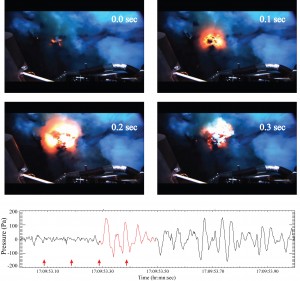17 April 2015
Volcanic soundscapes reveal differences in undersea eruptions (+ video)
Posted by Nanci Bompey
By Nanci Bompey
New research matching different types of underwater volcanic eruptions with their unique sound signatures could help scientists better detect and understand emissions occurring on the seafloor.
In 2009, scientists collected video and sound recordings of eruptions at the West Mata Volcano, 1,200 meters (3,937 feet) below sea level in the Pacific Ocean near Samoa. They found that different types of eruptions were occurring at two of the volcano’s vents: one was producing large lava bubbles that were released slowly from the volcanic vent before bursting, and the other exhibited a more chaotic, explosive release of hundreds of tiny gas bubbles. The videos of the eruptions were first unveiled that same year during the American Geophysical Union (AGU) Fall Meeting in San Francisco.
Scientists have now used these video and audio recordings, along with additional sound recordings, to figure out the unique acoustic signatures associated with both types of eruptions. These sound signatures could help scientists detect the different types of explosions going on at underwater volcanoes all over the ocean floor, said Bob Dziak, an oceanographer at the NOAA/Pacific Marine Environmental Laboratory in Newport, Oregon, and lead author of the new study published online in Geophysical Research Letters, an AGU journal.

This figure shows a video sequence of a magma gas bubble burst at one of the West Mata Volcano summit vents. The first three frames show the bubble growth and the final frame shows the collapse. The acoustic time series of bubble growth and bubble burst recorded by a hydrophone is shown below. Red arrows show the time of the four still images at the top.
Credit: Bob Dziak
For the past several decades, ocean researchers have been detecting the sounds of deep-sea volcanic explosions and eruptions using underwater sound recorders. But visual observations of these volcanic eruptions – either through use of a manned submersible or robotic vehicle — are very rare, Dziak said. Knowing the sound signatures of different eruptions could help scientists identify the type of eruption that is occurring by the audio alone, he said.
“Detecting seafloor volcanism is important because it is a very significant process in terms of chemical impacts on the ocean and natural hazards,” he said. Moreover, volcanic eruptions on the ocean floor can significantly affect marine animals and ecosystems, reshape the Earth’s ocean basins, and much more, Dziak added.
“Even though roughly 70 percent of Earth’s volcanic activity occurs under the water, it has remained largely unobserved,” he said. “So, the more of these events that we can detect remotely using acoustics, the more we can understand Earth’s processes and how the planet works.”
— Nanci Bompey is a public information specialist/writer at AGU.


 GeoSpace is a blog on Earth and space science, managed by AGU’s Public Information staff. The blog features posts by AGU writers and guest contributors on all sorts of relevant science topics, but with a focus on new research and geo and space sciences-related stories that are currently in the news.
GeoSpace is a blog on Earth and space science, managed by AGU’s Public Information staff. The blog features posts by AGU writers and guest contributors on all sorts of relevant science topics, but with a focus on new research and geo and space sciences-related stories that are currently in the news.